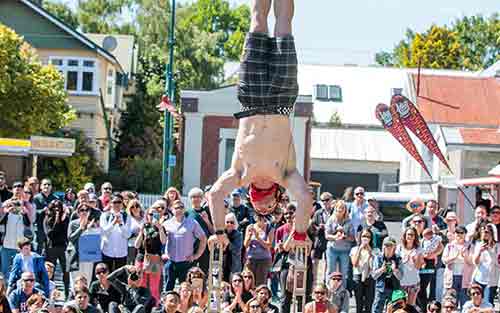
We are in the middle of The World Buskers Festival. I have written previously about busking as a model for worship – particularly for leading worship. So this post has a throwback-Thursday component.
I want to add to previous reflections a new thought. Busking is essentially street theatre – gathering a spontaneous crowd. I think I am correct that this is the twenty-fourth busking festival in Christchurch. This is a festival with a certain sense of status, of tradition, even of becoming part of the establishment. When the quakes destroyed the city, the buskers festival moved into our park. But now, with the restoration of many of our buildings underway (and new buildings begun), the buskers have moved into quadrangles and open spaces. They also have nightly events in halls and theatres. My point: there is an evolution away from spontaneous crowd/informal street event.
This week, as part of the Buskers Festival, I went to see Nina Conti. She was wonderful. She performed in the Christ’s College hall with about a thousand people who had all booked an paid for a ticket online.
Here is an idea of her performance:
There were, in her show, still many of the busking principles and components, but (I hope you are getting my point) there has been an evolution to booking, getting tickets (even to different prices getting different-quality seating), in a hall (rather than on the street),… It reminds me of some of the evolution that must have happened in the Early Church as Christian worship evolved from meals, began to include readings from Christian letters (and, later, Gospels), using inherited buildings, and finally adapting to being the religion of the Roman Empire…
What is gained? What is lost? What do we need to rediscover and renew?…
And another (new) point: at one busking event, as the busker was asking for money, he talked about this being his life and the source of his livelihood. Then he said being a busker is “difficult; rewarding; fun.” I think that is such a good description of being a priest, being a worship leader.
The dynamics of busking
- Gather a crowd – from individuals and small groups to a united audience (and get it to grow)
- Get the crowd to participate (clapping; call and response – there are standard ways of doing this that regular busking crowds know, and those who are new soon pick up from the regulars)
- Go through your fixed routine, adapting it to the context, and to the reaction of the people
- Send the people away satisfied and transformed (oh yes – get some of their money)
If you want to explore this model further, here are some previous posts:
Buskers – a model for leading worship
Busking & Liturgy
Buskers Lead Worship
If you appreciated this post, consider liking the liturgy facebook page, using the RSS feed, and/or signing up for a not-very-often email, …



Not that’s it’s entirely relevant here, but I’ve been reading a lot of British first person narratives from 19th Century Brazil recently. The popular expression of the faith as seen at that time in Brazil, a kind of religious Street ‘theater,’ was often denigrated as Romish popery. Or worse, idolatry.
I was surprised; I mean, who doesn’t like a full on procession from time to time? (And the Brazilians always had fireworks!)
It is interesting, in’t it, Kevin, that “Romish popery” would immediately be seen as denigration. Full-on processions are a feature of biblical worship – a requirement, in fact, several times a year, and part of Jesus’ life right up to the week in which he was executed (and presumably part of the reason he was executed). Blessings.